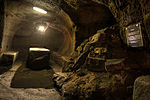The University of Edinburgh Medical School (also known as Edinburgh Medical School) is the medical school of the University of Edinburgh in Scotland and the United Kingdom and part of the College of Medicine and Veterinary Medicine, the head of which is Moira Whyte, who has also been head of the school since 2016. It was established in 1726, during the Scottish Enlightenment, making it the oldest medical school in the United Kingdom and is one of the oldest medical schools in the English-speaking world.
The medical school in 2021 was ranked 1st in the UK by the Guardian University Guide,. In 2013 and 2014, it was ranked 3rd in the UK by the Guardian University Guide, The Times Good University Guide. and the Complete University Guide. It ranked 21st in the world by the Times Higher Education World University Rankings 2013–14 and 22nd in the world by the QS World University Rankings 2014. According to a Healthcare Survey run by Saga in 2006, the medical school's main teaching hospital, the Royal Infirmary of Edinburgh, was considered the best hospital in Scotland.
The medical school's early focus on academic understanding puts its graduates amongst the top candidates in postgraduate qualification exams, and renders them very competitive applicants with regard to clinical posts.
As of 2017 the school accepts 184 medical students per year from the United Kingdom, 5 students from the European Union and an additional 14 students from elsewhere. Admission is very competitive, with an acceptance rate of 11.5% for the 2012–13 admissions year. The matriculation rate, the percentage of people who are accepted who choose to attend, is 71% for the 2012–13 admissions year. The school requires the 3rd highest entry grades in the UK according to the Guardian University Guide 2014.The medical school is associated with 3 Nobel Prize winners: 2 winners of the Nobel Prize in Physiology or Medicine and 1 winner of the Nobel Prize in Chemistry. Graduates of the medical school have founded medical schools and universities all over the world including 5 out of the 7 Ivy League medical schools (Harvard, Yale, Columbia, Pennsylvania and Dartmouth), Vermont, McGill, Sydney, Montréal, the Royal Postgraduate Medical School (now part of Imperial College London), the Cape Town, Birkbeck, Middlesex Hospital and the London School of Medicine for Women (both now part of UCL).







